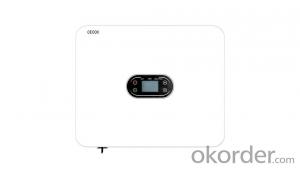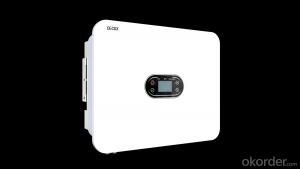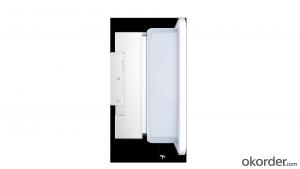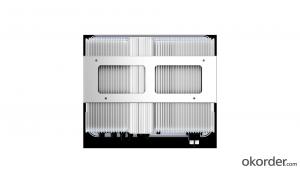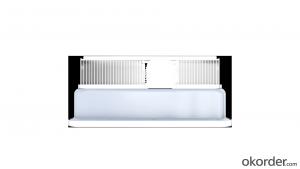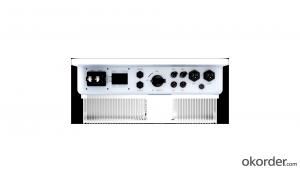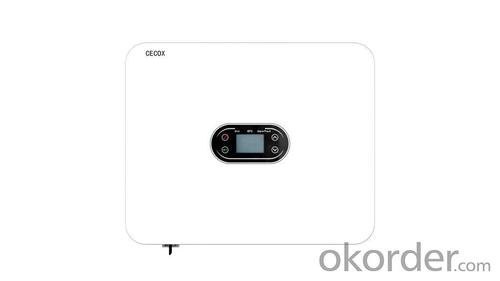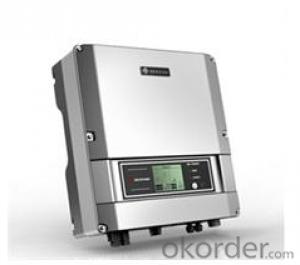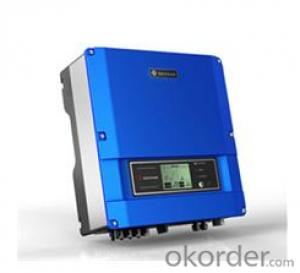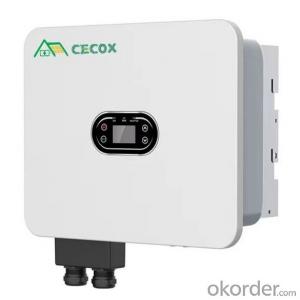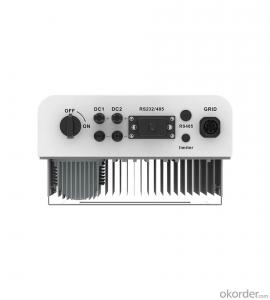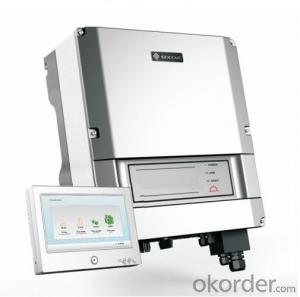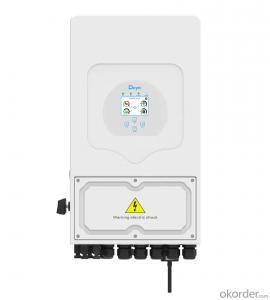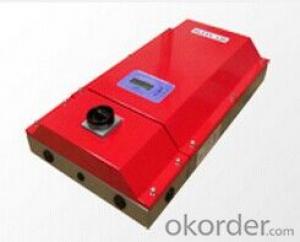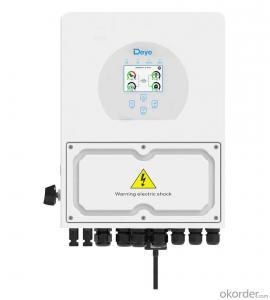3.6KW 4KW 4.6KW 5KW 6KW Single Phase Hybrid solar inverter
- Loading Port:
- SHENZHEN
- Payment Terms:
- TT OR LC
- Min Order Qty:
- 30 unit
- Supply Capability:
- 500 unit/month
OKorder Service Pledge
OKorder Financial Service
You Might Also Like
Specification
XD3.6kW-6kW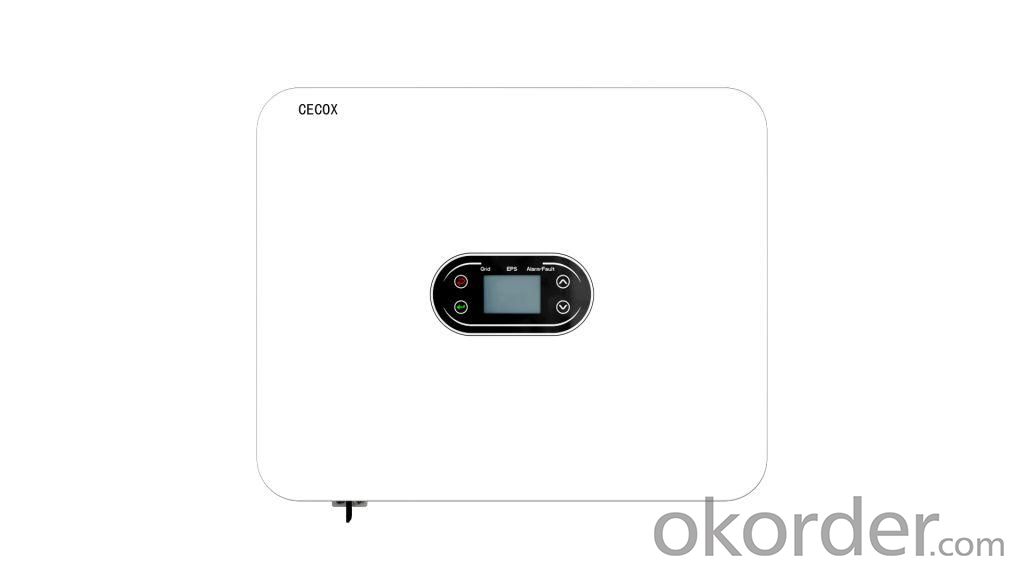
Single Phase Hybrid Inverter
XD3K6TL | XD4KTL | XD4K6TL | XD5KTL | XD6KTL | |
Input(PV) | |||||
Max.PV Input Power | 5.4kW | 6kW | 6.9kW | 7.5kW | 9kW |
Max.PV Input Voltage | 550V | ||||
Start-up Voltage | 100V | ||||
Rated Voltage | 240V | 270v | 300V | 330V | 360v |
MPPT Voltage Range | 100v~550v | ||||
Number of MPP Trackers | 2 | ||||
Max.PV Input Current | 16A | ||||
Output(AC) | |||||
Rated Output Power | 3.68kVA | 4kVA | 4.6kVA | 5k/A | 6kVA |
Max.Output Power | 3.68kVA | 4.4kVA | 4.6kVA | 5.5kVA | 6kVA |
Max.Output Current | 16A | 20A | 20.9A | 22.7A | 30A |
Rated Voltage | 230V | ||||
Rated Frequency | 50Hz/60Hz | ||||
THDi (@Rated Power) | <3% | ||||
Power Factor | 0.8leading-0.8lagging | ||||
Battery | |
Battery Type | Lithium, Lead-acid |
Battery Voltage Range | 40V~60v |
Max.Charge / Discharge Current | 100A |
Communication | CAN |
Efficiency | |
Max Efficiency | 97.5% |
EU Efficiency | 97.2% |
Battery Charge/Discharge Efficiency | 95% |
Protection | |
DC Reverse Polarity Protection / Insulation | Yes |
Over Current / Over Voltage Protection | Yes |
Battery Soft Start Protection | Yes |
AFCI Protection | Optional |
Surge Protection | Type ll |
Communication | |
Display | LCD |
Communication | RS485/CAN/WIFI/4G/LAN/ Bluetooth |
General Data | |
Dimension (W*H*D) | 490x 395x 200 mm |
Weight | 15kg |
Operating Temperature Range | -30℃~+60℃ |
Cooling Method | Natural |
Protection Degree | IP66 |
Max.Operating Altitude | 4000 m |
Noise | ≤25dB |
Relative Humidity | 0~100% |
Self-consumption | <10w |
Topology | High Frequency Insolation (For battery) |
MARKETING & SERVICE NETWORK
CNBM global sales team provides customers with professional and efficient pre-sale, in sale and after-sale services,
and enhances the added value of the brand with high-quality services.
Products Details:
High voltage protection Over load protection
Battery reverse connected protection Dust-proof
Low voltage protection Overheating protection
Output short-circuit protection Insect prevention
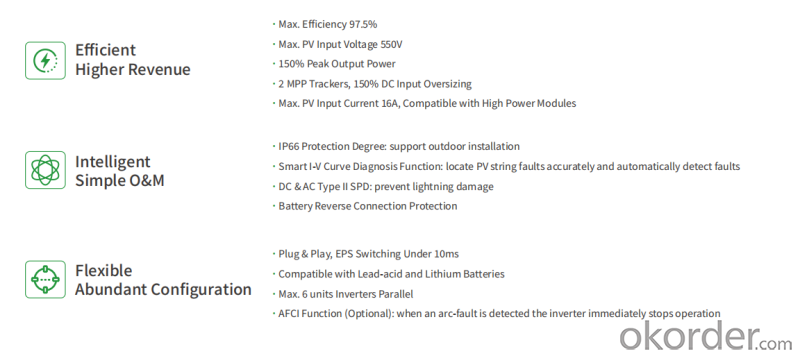
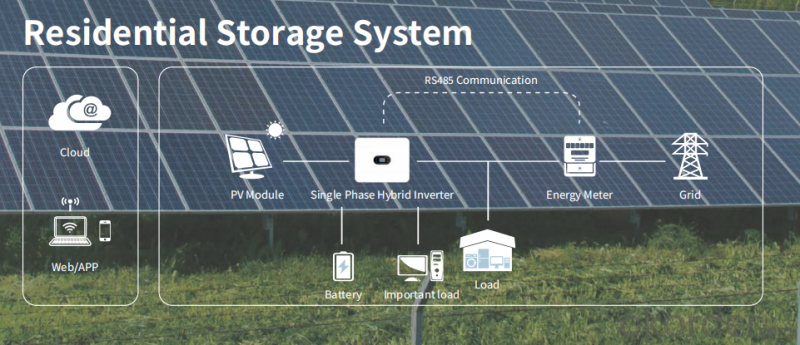

FAQ:
Q1:May I take some samples to test before placing the order ?
A1:Yes, welcome to take some sample to test!
Q2:How about the delivery time?
A2:7 days for sample; 25 days for bulk order.
Q3:What is the warranty of the controller?
A3:1 years warranty.
Q4:How to solve the technical problems?
A4:24 hours after-service consultancy just for you and to make your problem to be solved easily.
Q5:What payment methods do your company support?
A5:T/T, Western Union, Paypal, L/C etc.
Q6:What are the price terms can you offer for us?
A6:We can accept EXW, FOB, CIF and so on.
Q7:Do you have any certifications for your products?
A7:We have ISO9001:2000, CE, RoHS, certificates for all of our products.
- Q: Can a solar inverter be used in harsh environmental conditions?
- Yes, solar inverters are designed to withstand harsh environmental conditions such as extreme temperatures, high humidity, and exposure to dust, dirt, and corrosive elements. They are built with robust materials and undergo rigorous testing to ensure their durability and reliability in challenging environments. Additionally, some solar inverters come with IP65 or higher ratings, indicating their resistance to water and dust ingress, making them suitable for installation in outdoor and harsh conditions.
- Q: How does a solar inverter work?
- A solar inverter works by converting the direct current (DC) electricity produced by solar panels into alternating current (AC) electricity that can be used to power household appliances and be fed into the electrical grid. It performs this conversion by using electronic components, such as transistors and capacitors, to change the voltage and frequency of the electricity. The inverter also monitors the solar panel's output and adjusts its operation to ensure optimal performance and efficiency.
- Q: What is the role of a solar inverter in preventing system failures?
- The role of a solar inverter in preventing system failures is to convert the direct current (DC) produced by solar panels into alternating current (AC) that can be used by household appliances and sent back to the electrical grid. By ensuring that the DC power generated by the solar panels is properly converted and synchronized with the grid, the inverter helps maintain the stability and reliability of the entire solar power system. Additionally, the inverter monitors the voltage, frequency, and overall performance of the system, allowing it to detect and respond to any potential issues or faults that could lead to system failures.
- Q: How does a solar inverter handle voltage unbalance in the grid?
- A solar inverter handles voltage unbalance in the grid by employing its control algorithms to monitor and regulate the output voltage. When the solar inverter detects an unbalanced grid voltage, it adjusts the output voltage accordingly to maintain a balanced supply. This is typically achieved by injecting reactive power or adjusting the phase angle of the output voltage to synchronize it with the grid. By actively managing voltage unbalance, a solar inverter ensures stable and reliable power conversion in the presence of grid voltage fluctuations.
- Q: What is the role of a power quality analyzer in a solar inverter?
- A power quality analyzer in a solar inverter is responsible for monitoring and analyzing various electrical parameters such as voltage, current, frequency, harmonics, and power factor. It ensures that the solar inverter is operating efficiently and delivering high-quality power to the grid. By detecting and diagnosing any power quality issues, the analyzer helps in identifying potential problems, optimizing energy production, and maintaining the overall performance and reliability of the solar inverter system.
- Q: Can a solar inverter be connected to a smartphone app for monitoring?
- Yes, a solar inverter can be connected to a smartphone app for monitoring. Many modern solar inverters have built-in Wi-Fi or Bluetooth capabilities that allow them to connect to a smartphone app. This app provides real-time monitoring of the solar system's performance, including energy production, consumption, and any potential issues or faults. It also allows users to remotely control and adjust settings of the inverter for optimized energy management.
- Q: How does a solar inverter handle grid islanding conditions?
- A solar inverter detects grid islanding conditions by monitoring the voltage and frequency of the grid. When it detects a deviation from the normal range, indicating an islanding event, it immediately stops supplying power to the grid. This is done to ensure the safety of utility workers who may be repairing the grid.
- Q: Can a solar inverter be used with different types of power conditioning units?
- Yes, a solar inverter can be used with different types of power conditioning units as long as they are compatible and properly integrated into the solar power system. The inverter's specifications and features should be considered to ensure compatibility with the specific power conditioning unit being used.
- Q: What is the temperature range for optimal operation of a solar inverter?
- The temperature range for optimal operation of a solar inverter is typically between -20°C to 50°C.
- Q: How does a solar inverter handle voltage fluctuations during grid disturbances?
- A solar inverter handles voltage fluctuations during grid disturbances by continuously monitoring the grid voltage. When a disturbance occurs, such as a sudden drop or increase in voltage, the inverter's control system detects it and adjusts the output voltage accordingly. This allows the inverter to stabilize the voltage and ensure a consistent supply of electricity to the connected solar panels or the grid.
Send your message to us
3.6KW 4KW 4.6KW 5KW 6KW Single Phase Hybrid solar inverter
- Loading Port:
- SHENZHEN
- Payment Terms:
- TT OR LC
- Min Order Qty:
- 30 unit
- Supply Capability:
- 500 unit/month
OKorder Service Pledge
OKorder Financial Service
Similar products
Hot products
Hot Searches
Related keywords
